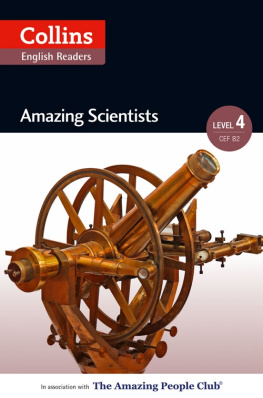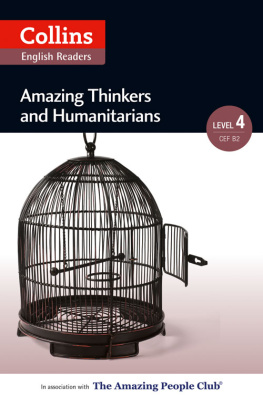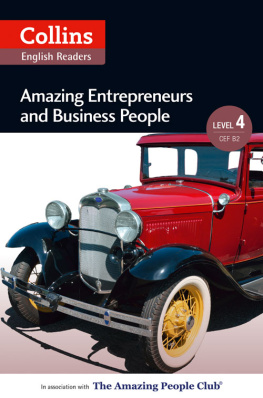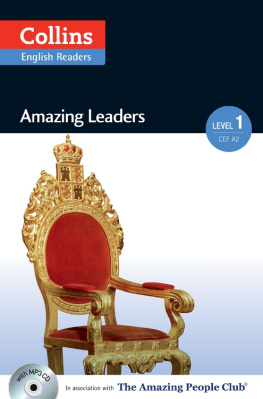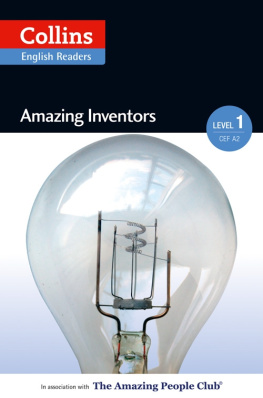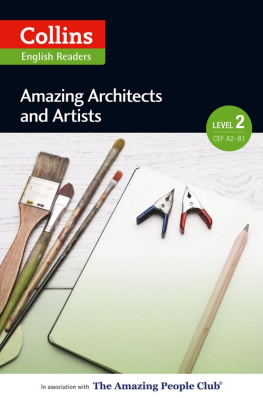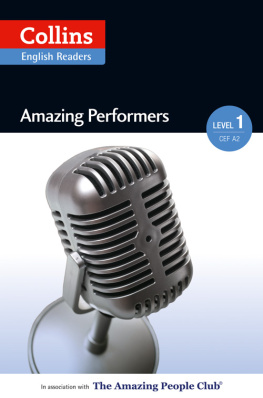Collins Amazing People Readers are collections of short stories. Each book presents the life story of five or six people whose lives and achievements have made a difference to our world today. The stories are carefully graded to ensure that you, the reader, will both enjoy and benefit from your reading experience.
You can choose to enjoy the book from start to finish or to dip in to your favourite story straight away. Each story is entirely independent.
After every story a short timeline brings together the most important events in each persons life into one short report. The timeline is a useful tool for revision purposes.
Words which are above the required reading level are underlined the first time they appear in each story. All underlined words are defined in the glossary at the back of the book. Levels 1 and 2 take their definitions from the Collins COBUILD Essential English Dictionary and levels 3 and 4 from the Collins COBUILD Advanced English Dictionary.
To support both teachers and learners, additional materials are available online at www.collinselt.com/readers.
The Amazing People Club
Collins Amazing People Readers are adaptations of original texts published by The Amazing People Club. The Amazing People Club is an educational publishing house. It was founded in 2006 by educational psychologist and management leader Dr Charles Margerison and publishes books, eBooks, audio books, iBooks and video content which bring readers face to face with many of the worlds most inspiring and influential characters from the fields of art, science, music, politics, medicine and business.
The Collins COBUILD Grading Scheme has been created using the most up-to-date language usage information available today. Each level is guided by a brand new comprehensive grammar and vocabulary framework, ensuring that the series will perfectly match readers abilities.
CEF band | Pages | Word count | Headwords |
Level 1 | elementary | A2 | | 5,0008,000 | approx. 700 |
Level 2 | pre-intermediate | A2B1 | | 8,00011,000 | approx. 900 |
Level 3 | intermediate | B1 | | 11,00015,000 | approx. 1,100 |
Level 4 | upper intermediate | B2 | | 15,00018,000 | approx. 1,700 |
For more information on the Collins COBUILD Grading Scheme, including a full list of the grammar structures found at each level, go to www.collinselt.com/readers/gradingscheme.
Also available online: Make sure that you are reading at the right level by checking your level on our website (www.collinselt.com/readers/levelcheck).

17451827
the man who invented the battery

Before electricity, people lived half their lives in darkness. We relied on horses for transport. The basic ingredients had been available for over 2,000 years, so why did it take us so long to learn to use the power of electricity?

On 18th February 1745, I was born into a wealthy family, in Como in northern Italy. Both my parents, my mother, Donna Maddalena and my father, Filippo, came from high-class Catholic families. I was a very introverted child, and even by the age of four, I wasnt speaking. My family thought that I was unable to speak, that I lacked the intelligence to do so. Despite this, I was sent to the local Catholic school, run by priests, and by the time I was seven, I had surprised everybody. Far from being stupid, I was really quite clever. At this time, my father died, which affected me deeply and I became even quieter and less communicative. My uncle, who took over the responsibility for my education, and the teachers at school, wanted me to become a priest. This had been the career of other members of my family and it seemed suitable for me, too. I, however, was not interested in joining the church and I refused. My familys second career choice for me was law. I wasnt very keen on becoming a lawyer either. When I was fifteen, I started studying natural philosophy at school. I was a good student and I also liked reading and studying languages, something I appeared to be talented in because I learnt to speak Latin, French, English, Dutch, Spanish, Russian and Greek. I liked writing poetry, too. My real interests, however, were physics and chemistry.
I was fascinated by the way things worked and I read all the science books I could find, especially if they were about electricity, which I was really interested in. In 1763, when I was 18, I started to write letters to a French physicist , who was also a priest, called Jean-Antoine Nollet. Nollet had been doing experiments with electricity. In 1748, he had invented the electroscope a machine that could find whether there was an electric charge present in something or not. He was also fond of demonstrating the results of his research and his lectures soon became popular. One spectacular demonstration was done in front of King Louis XV at the Palace of Versailles in France. Nollet managed to pass an electrical charge through 180 people. For this demonstration he used 180 soldiers and something called a Leyden jar. This was an ordinary glass jar which was lined with paper-thin sheets of tin a metal, and three-quarters filled with water. At the top of the jar there was a cork through which passed a thin metal wire. The wire was attached to a metal chain outside the jar to allow the electrical charge to pass into the jar. Nollet asked the soldiers to stand in an open circle and hold hands. When he told them to, the first and last soldier each touched the jar, completing the circle. The electricity passed through each soldier at the same time with the result that all 180 soldiers jumped into the air simultaneously. The king was highly amused by this and made Nollet repeat the demonstration using priests. Nollet did many other demonstrations and experiments and news of his work spread throughout the scientific community.
I had decided not to go to university to study when I left school. At this stage I had not yet started doing my own experiments and I really wanted to learn as much as I could from Nollet. He later became the first Professor of Experimental Physics at the University of Paris. I was also in contact with Professor Giovanni Battista Beccaria of the University of Turin and I sent him a paper I wrote in Latin called On the attractive force of electric fire. Later, in 1769, it was published. I started doing my own experiments. This was a slow process and I made many mistakes. I also learnt a great deal and in 1774, when I was 29, I became Professor of Physics at the Royal School in Como.

Ten years previously, a Swedish physicist called Johan Wilcke had invented a generator which produced static electricity . In 1775, I invented an improved version of his generator, called the electrophorus. My invention was more useful because it was able to produce a larger amount of static electricity and to produce it continuously. Later it was developed so that it could store electricity.

